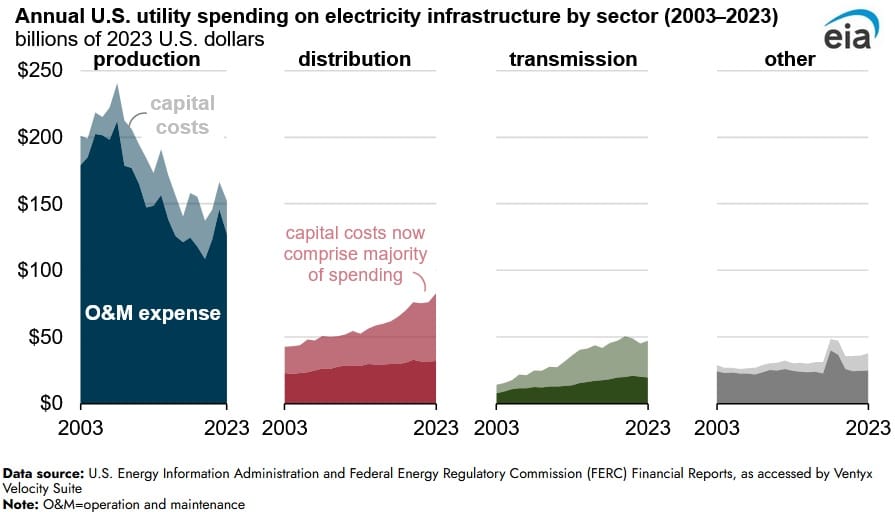U.S. Utility Spending Over Two Decades Rose Due to Grid Investments: EIA

Major utilities have increased their annual spend to produce and deliver electricity over the last two decades, according to an Nov. 18 report published by the U.S. Energy Information Administration. Annual spend rose 12 percent from $287 billion during 2003 to $320 billion during 2023. The increase in annual spend can be attributed to capital investment in electric infrastructure which has more than doubled over the 2003-2023 period.
In recent years major utilities have spent extensively on replacing and enhancing old generation and delivery infrastructure, in order to combat storm and fire damage. Utilities have also invested in installing various electricity generation assets over the last two decades, which are compatible with the various sources in the generation mix, including natural gas fired generation, solar and wind generation, and battery storage. Utility expenditures have also increased to connect new lines to renewable energy sources and the rollout of new technology to the distribution system.
The cost to produce electricity declined 24 percent from 2003 to 2023, in line with lower fuel costs due to increasing renewable generation and the phasing out of old, costly fossil fuel plants. Spending on electricity production includes the cost of fuels, capital, labor, and building materials, as well as the type of generators being built.
Expenditure on the electricity transmission system increased by nearly threefold from 2003 to 2023 reaching $27.7 billion. Utility spending on electricity delivery includes the money spent to build, operate, and maintain the electric wires, poles, towers, and meters that make up the transmission and distribution system. Capital expenditure on the distribution system, whose main function is to deliver electricity to end users, was the key driver of electricity expenditure rises over 2003 to 2023 period. Capital investment in distribution infrastructure rose by $31.4 billion over the last two decades. Over 20 percent of this rise happened between 2022 and 2023 when costs increased by $6.5 billion to an overall outlay of $50.9 billion as utilities changed and enhanced old equipment and installed new lines and other equipment to assist local electricity network grids resist extreme weather conditions and to supervise the unpredictability of renewable energy resources.
Utilities expenditure on other electricity systems rose by $8.6 billion or 30 percent. Majority of these increases (92 percent) were expended on intangible plant expenses, such as licences and franchises and general plant expenditures.
EnerKnol Pulses like this one are powered by the EnerKnol Platform—the first comprehensive database for real-time energy policy tracking. Sign up for a free trial below for access to key regulatory data and deep industry insights across the energy spectrum.
ACCESS FREE TRIAL